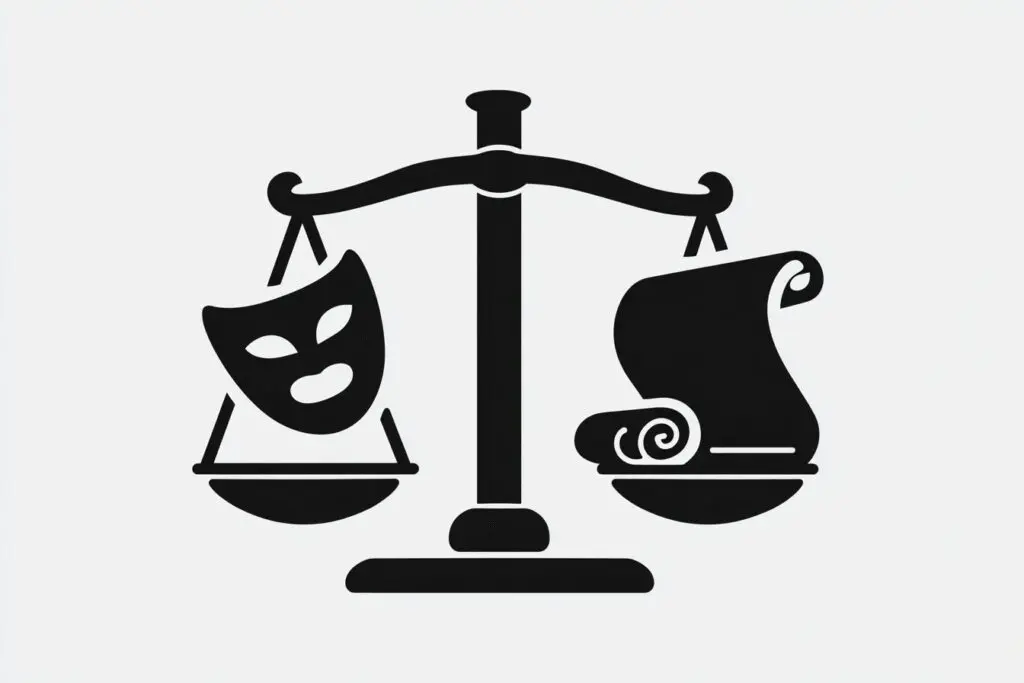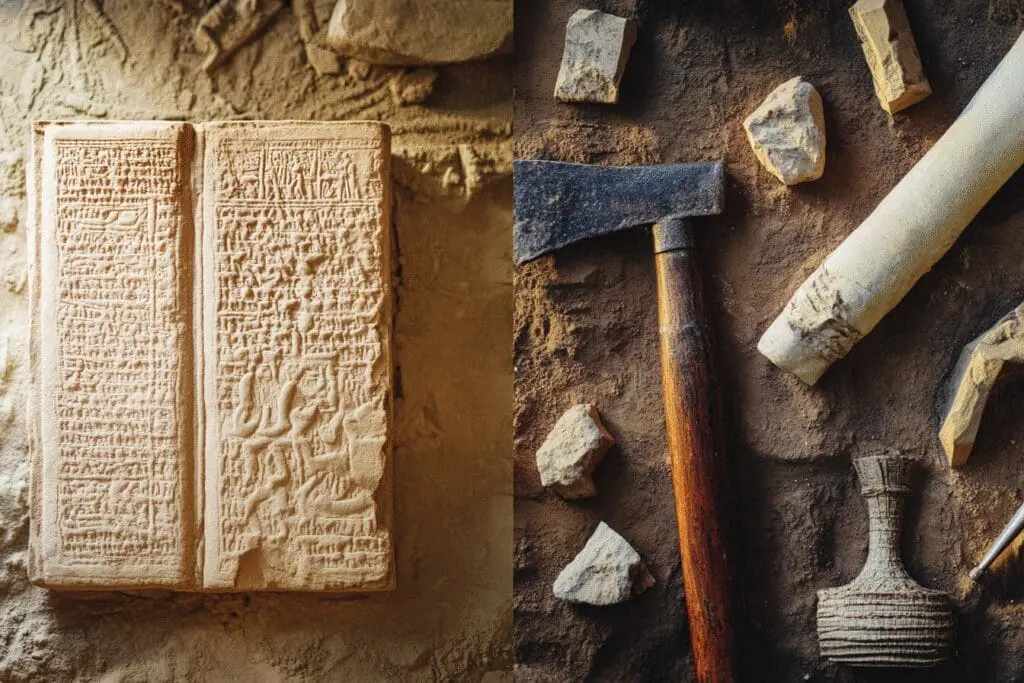I was probably about ten years old, sitting on a stiff wooden pew and staring at a picture of Noah’s Ark in a children’s Bible. Even then, my brain was buzzing with questions. How did they fit all the animals? What did they do with all the… you know… poop? It seemed more like a fantastical story than something that actually happened.
Now, at 31, that feeling hasn’t exactly gone away. It’s just gotten more complicated. I’m not in Sunday school anymore, but the Bible is still everywhere. It’s quoted by politicians, referenced in movies, and sits on the bedside table in countless hotel rooms. Which brings me back to that fundamental, nagging question: Is the Bible fiction or nonfiction?
It feels like you’re only given two options: either you accept the whole thing as the literal, inerrant word of God, or you dismiss it as a collection of outdated fairy tales. But what if the answer isn’t that simple? What if it’s somewhere in the messy middle? I’m not a pastor or a theologian. I’m just a guy with a healthy dose of curiosity and a desire to understand what’s real. So, I decided to dig in, not from a place of faith or disbelief, but from a simple desire to see what historical facts we can actually point to.
More in Bible Category
What Did Jesus Say About the Bible
What Bible Do Eastern Orthodox Use
Key Takeaways
For those of you who just want the highlights, here’s the short version of what I’ve found:
- The Bible Isn’t One Book: It’s a library of 66 different books written by various authors over centuries. These books include different genres like history, law, poetry, and letters. Asking if “the Bible” is true is like asking if “the library” is true.
- Real People, Real Places: Archaeology and historical records have confirmed the existence of many people (like King David and Pontius Pilate) and places (like Jerusalem and Jericho) mentioned in the Bible.
- It’s Not a Modern History Textbook: The authors weren’t writing objective, 21st-century history. They were writing from a faith perspective to convey theological truths. The history is the stage, but theology is the play.
- The Manuscript Evidence is Surprisingly Strong: Thanks to discoveries like the Dead Sea Scrolls, we know the text wasn’t just a game of “telephone.” The scriptures were copied with incredible care over thousands of years.
- Miracles Are a Matter of Worldview: History and science can’t prove or disprove supernatural events. That part ultimately comes down to a personal leap of faith (or lack thereof).
Okay, So Where Do You Even Start With This Thing?
The first mistake I made was thinking of the Bible as one single, continuous book. If you try to read it from Genesis to Revelation like a novel, you’re going to get confused and probably give up somewhere in the dense legal codes of Leviticus. Trust me, I’ve tried.
A much better way to think about it is as a collection—a library, really. It’s split into two main sections:
- The Old Testament: This is the story of ancient Israel. It has books of law (like Exodus), books of history (like 1 & 2 Kings), books of poetry (like Psalms), and books of prophecy (like Isaiah).
- The New Testament: This section focuses on the life of Jesus of Nazareth and the early Christian church. It contains four biographies of Jesus (the Gospels), a history of the early church (Acts), letters to various churches and individuals (like Romans and Philemon), and a book of apocalyptic prophecy (Revelation).
When you see it this way, the question “Is it fiction or nonfiction?” becomes much more nuanced. A book of poetry isn’t “false” just because it’s not a literal historical account. A legal document isn’t a story. They’re different kinds of writing meant for different purposes.
But Did Any of These People or Places Actually Exist?
This was the first big question for me. If the Bible is set in a fantasy world like Middle-earth, then the conversation ends pretty quickly. But if it’s set in our world, with real locations and people, then we have something to investigate. It turns out, there’s more solid ground here than I initially thought.
The “Big Names” – What’s the Evidence for Them?
You’d think figures as monumental as King David or Jesus would have mountains of evidence, but ancient history is tricky. Records are often sparse or destroyed. Still, archaeologists have found some fascinating clues that line up with the biblical accounts.
- King David: For a long time, scholars thought David might be a mythical figure, like King Arthur. There was no mention of him outside the Bible. Then, in 1993, archaeologists found a stone inscription in northern Israel, now called the Tel Dan Stele. It was erected by an enemy king, and it boasts of his victories over the “King of Israel” and the “House of David.” This was huge. It was the first extra-biblical reference to King David’s dynasty, suggesting he was a real historical figure.
- Pontius Pilate: He’s the Roman governor who, according to the Gospels, oversaw the trial and crucifixion of Jesus. In 1961, a team of archaeologists excavating an ancient theater in Caesarea Maritima, a Roman coastal city, found a limestone block. Inscribed on it were the words “Pontius Pilate, Prefect of Judea.” It was a dedication stone for a temple, and it confirmed he was exactly who the Bible said he was, holding the exact title the Bible gives him.
- Jesus of Nazareth: When it comes to Jesus, the evidence is different. We don’t have a birth certificate or an inscription with his name on it. But we do have multiple, independent accounts from non-Christian historians writing within a century or so of his life. The Roman historian Tacitus and the Jewish historian Flavius Josephus both wrote about a man named Christus (or Christ) who was executed by Pontius Pilate in Judea and had started a movement that had spread to Rome. These accounts don’t prove he was the Son of God, of course, but they firmly establish his existence as a real person in history.
What About the Cities? Are They Real?
It’s one thing for a person to exist; it’s another for the entire geographical setting to be real. And on this front, the evidence is overwhelming. The cities of the Bible are not mythical places. They are real locations that you can visit today.
I remember watching a documentary about archaeologists finding the Pool of Siloam in Jerusalem. It’s a place mentioned in the Gospel of John, where Jesus supposedly healed a blind man. For centuries, people thought they knew where it was, but it turned out they were wrong. Then, during a construction project, workers uncovered stone steps that archaeologists confirmed were part of the actual first-century pool. Seeing that on my screen, I got chills. A story I’d always pictured in my head suddenly had a physical, tangible reality. It felt different.
The list goes on. We’ve found the remains of Jericho, the fishing village of Capernaum where Jesus based his ministry, and of course, Jerusalem itself, a city layered with thousands of years of history that aligns with its biblical descriptions.
So, If Some Parts Are Historically Grounded, Why All the Skepticism?
This is where things get complicated. Finding a real city or a real governor doesn’t automatically mean every story that takes place there is 100% factual. The Bible makes some claims that are, to put it mildly, hard to verify.
The Problem of Miracles and the Supernatural
Here’s the thing: history and archaeology can only tell us what could have happened, not what must have happened. A historian can confirm that there was a man named Jesus who was crucified by the Romans. But that same historian can’t prove that he rose from the dead three days later. That’s not a historical question; it’s a supernatural one.
Events like the parting of the Red Sea, turning water into wine, or walking on water are, by definition, outside the normal rules of nature. You can’t dig up evidence of a miracle. This is the point where the Bible’s claims move beyond the scope of historical analysis and into the realm of faith. For me, this is the biggest hurdle. I can follow the historical breadcrumbs, but then the path leads to the edge of a cliff, and the book asks you to leap. History can’t make that leap for you.
When the Timeline Gets… Messy
Another point of contention is that the Bible sometimes seems to contradict itself or known history. The accounts of Jesus’s birth in Matthew and Luke, for instance, are notoriously difficult to harmonize with each other and with the historical records of the Roman census. The four Gospels sometimes report the same event with different details.
And then you have Genesis. The first two chapters give two different-sounding accounts of creation. For a long time, this was seen as a huge problem. But most scholars today, including many religious ones, don’t read Genesis as a scientific textbook. They see it as a form of ancient writing known as “theological history.” Its purpose isn’t to explain the “how” of creation with scientific precision but the “who” and “why.” It’s an ancient culture’s foundational story about its relationship with God and the world. It’s answering questions like, “Who are we?” and “Why is there suffering?” not “How many years ago did the Big Bang happen?”
Is the Bible Just a Game of “Telephone” Over a Thousand Years?
This was another one of my big hang-ups. These stories were written down thousands of years ago. How do we know we even have what the original authors wrote? Hasn’t it been changed and corrupted over the centuries, like a message whispered from person to person?
The Dead Sea Scrolls: A Game-Changer
In 1947, a young Bedouin shepherd was looking for a lost goat near the Dead Sea. He tossed a rock into a cave and heard the sound of shattering pottery. What he found inside would change our understanding of the Bible forever. The caves contained hundreds of ancient scrolls, hidden for nearly 2,000 years.
These were the Dead Sea Scrolls. They included copies of almost every book in the Old Testament. The amazing part? These scrolls were a full thousand years older than the manuscripts we had been using as the basis for our Old Testament. This was the ultimate test of the “telephone game” theory.
The verdict? The texts were remarkably, almost miraculously, consistent. When scholars compared the newly found scroll of Isaiah with the version they already had, it was over 95% identical. The differences were mostly minor spelling variations and obvious scribal slips. It proved that the Jewish scribes had a meticulous, painstaking system for copying their sacred texts. It wasn’t a game of telephone
What about the New Testament?
The New Testament has its own compelling manuscript evidence. When you compare it to other classical works, it’s not even a contest. For most ancient authors, like Plato or Caesar, we might have a dozen or maybe a couple hundred surviving manuscripts, and most of them were copied 500 to 1,000 years after the original was written.
For the New Testament, we have over 5,800 Greek manuscripts, with some fragments dating as early as the second century, just a few generations removed from the eyewitnesses. This wealth of material allows scholars to cross-reference the documents and reconstruct the original text with an incredibly high degree of accuracy. As the University of North Carolina at Chapel Hill’s library guide explains, this process of textual criticism is a rigorous academic discipline. While there are variations among manuscripts, the core of the text is not in doubt. It’s like having thousands of photos of the same event; even if some are blurry or taken from different angles, you can still get a very clear picture of what happened.
So, What’s the Verdict? Fiction, Nonfiction, or Something Else?
After diving into all of this, I’ve come to the conclusion that forcing the Bible into a modern box labeled “fiction” or “nonfiction” just doesn’t work. It’s like trying to fit a square peg into a round hole. The Bible is an ancient, complex library of books, and we need to appreciate it for what it is, not what we think it should be.
It’s Not a History Book, But It Contains History
The primary purpose of the Bible is not to be a dispassionate record of historical events. It is a work of theology. It’s a grand story about God’s relationship with humanity, told from the perspective of faith. But to make that story resonate, to ground it, the authors set it in real places, with real people, and during real historical events.
The history it contains is in service of its theological message. So, yes, there is history in the Bible. But it’s not there for its own sake. It’s the stage upon which a much larger drama unfolds.
My Take on It at 31
Look, I’m not a theologian. I’m just a guy who’s trying to make sense of this massive, influential book. For me, calling it “fiction” feels dishonest. There are just too many real places, verified people, and historical anchor points. The manuscript evidence is too strong to dismiss it as a legend that got out of hand.
But calling it pure “nonfiction,” in the way we think of a modern biography or a science textbook, doesn’t work either. It describes supernatural events that are beyond proof, and it asks the reader to accept them. It contains poetry, prophecy, and letters full of personal advice.
So maybe we’re just asking the wrong question. Maybe the real question isn’t “Is the Bible fiction or nonfiction?” Maybe a better question is, “What truths is it trying to tell?” Whether it’s historical truth, moral truth, or spiritual truth, that’s a much more personal journey. And honestly, I think that’s a journey worth taking.
Frequently Asked Questions – Is the Bible Fiction or Nonfiction

Can the miracles in the Bible, such as the resurrection, be proven historically?
Miracles like the resurrection cannot be proven through history or science, as they are outside natural laws. However, the historical accounts in the Bible and the transformed lives of the disciples provide strong reasons for faith in these supernatural events.
Does the large number of ancient manuscripts prove the Bible has not been changed over time?
The vast number of ancient manuscripts of the New Testament, over 5,800 Greek copies and many more in Latin and other languages, shows that the text has been preserved accurately. While minor variations exist, they rarely affect core beliefs, indicating the Bible we have today is very close to the original writings.
Is there evidence outside the Bible that confirms the life of Jesus?
Yes, non-Christian historians like Tacitus and Josephus wrote about Jesus, confirming that he was a real person who lived, was crucified, and had a significant impact. These external sources reinforce the historical reliability of the Gospel accounts.
How do archaeological discoveries support the historical reliability of the Old Testament?
Archaeological discoveries, such as the ruins of the Hittite empire, the Tel Dan Stele confirming King David’s existence, and Hezekiah’s tunnel, provide physical evidence that the places and events described in the Old Testament were real, supporting its historical reliability.
What does it mean to say the Bible is ‘nonfiction’ and how does this relate to its historical accuracy?
To say the Bible is ‘nonfiction’ means that its historical stories are based on real events and people. Archaeological findings and external historical sources support the idea that many of the Bible’s accounts correspond to actual historical facts, even though some details are still studied and debated.




